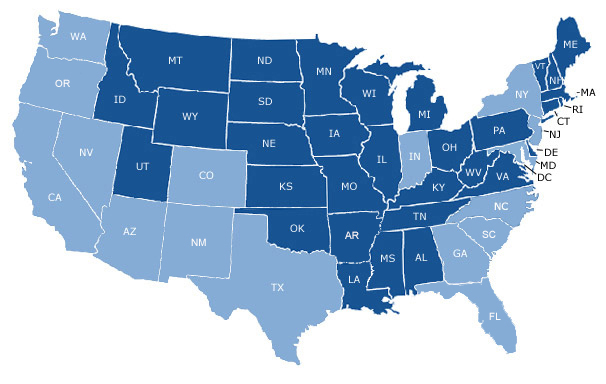State Water Facts
Every region of America has its own unique topography, climate, and water needs. Learn more about the vital role water plays in your area by clicking on a state below. Check back often for additional fact sheets!

- Arizona
- California
- Colorado
- Florida
- Georgia
- Indiana
- Maryland
- Nevada
- New Jersey
- New Mexico
- New York
- North Carolina
- Oregon
- South Carolina
- Texas
- Washington
Like other southwestern states, Arizona has withstood many years of water shortages. With a naturally arid climate and a significant population increase in the last decade, Arizona will continue to be challenged by water supply issues. The state is focused on supply management, conservation programs, and water efficiency education to meet the challenge.
Learn more about Arizona's water facts with this Fact Sheet. (2 pp, 475K, About PDF)
California is a mosaic of diverse culture, climate, and geography from its hot, dry deserts to its snowcapped peaks and foggy shores. The state’s varying water needs and resources are both a reflection and a consequence of this diversity. Balancing water supply and demand is a perennial problem for California. Californians are no strangers to droughts and water restrictions. This has made the state a national leader in water efficiency and conservation initiatives.
Learn more about California's water facts with this Fact Sheet. (2 pp, 1,125K, About PDF)
Just as Colorado's topography varies from the towering Rocky Mountains in the West to the flat Eastern Plains, the state's freshwater resources fluctuate depending upon location and elevation. Despite relatively abundant precipitation in Colorado's mountains, most of the state is semi-arid and heavily dependent upon annual snowmelt and its runoff from the mountains to the plains, where a majority of the population resides and most of the state's water is used. Because no major rivers flow into Colorado, the state relies nearly entirely on precipitation to replenish its freshwater resources. In fact, the Rocky Mountain states obtain 70 to 90 percent of their water from snowmelt, so a dry winter can mean drought in the summer.
Learn more about Colorado's water facts with this Fact Sheet. (2 pg, 961K, About PDF)
Florida is surrounded by water and is home to the second largest freshwater lake wholly contained within the United States, Lake Okeechobee. Natural beauty and warm temperatures attract a large population; Florida is the nation’s fourth most populous state, with the number of residents continuing to rise.
Learn more about Florida's water facts with this Fact Sheet. (2 pg, 391K, About PDF)
From the expanding Atlanta metropolitan region suburbs to the world–class golf courses on the Atlantic Coast, Georgia’s economy depends upon a consistent supply of fresh water. Though Georgia has a humid climate and a statewide annual rainfall of 51 inches, periodic water shortages have become a fact of life for the state’s residents. Such shortages are triggered not only by occasional droughts, but also by uncertain aquifer supplies and a dwindling number of new surface water sources available to satisfy the state’s growing population.
Learn more about Georgia's water facts with this Fact Sheet. (2 pp, 471.7K, About PDF)
Indiana has more than 35,000 miles of rivers and streams, 100,000 acres of publicly owned lakes and reservoirs, and 50 miles of Great Lakes shoreline. These surface water resources play a crucial role in industry, agriculture, and energy production in the state. About two-thirds of Indiana's population depends on ground water for drinking and household uses. Indiana is generally considered to have adequate water resources to satisfy its domestic, industrial, and environmental water supply needs, but as it looks to the future, Indiana is focusing on using water more efficiently across the state, to address its growing population and protect this precious natural resource.
Learn more about Indiana's water facts with this Fact Sheet. (2 pp, 1.46MB, About PDF)
Maryland’s direct access to the Potomac River, Chesapeake Bay, and Atlantic Ocean makes it a haven for water lovers, water sports, and fishing. However, the state’s climate, geology, and significant droughts in recent years have highlighted critical freshwater supply issues throughout this Mid-Atlantic state.
Learn more about Maryland's water facts with this Fact Sheet. (2 pg, 752.5K, About PDF)
Nevada is the driest state in the United States, with an average annual precipitation rate of 9.5 inches. The southern region of Nevada accounts for nearly three-quarters of the state’s water demand and averages only four inches of precipitation per year. The region’s water demands are projected to increase by 85 percent by 2065. Nevada’s desert climate, growing population, and ongoing drought conditions stress the state’s existing water supply, making water efficiency critical.
Learn more about Nevada's water facts with this Fact Sheet. (2 pp, 637K, About PDF)
Location. Location. Location. It's New Jersey's greatest asset—from the sandy beaches of the Jersey Shore to the bright lights of Atlantic City. Close proximity to New York City and Philadelphia also make New Jersey the state with the highest population density in the United States. Though generally considered a "water rich" state with an average rainfall of 45 inches per year, New Jersey faces long-term water issues as its population continues to grow—while water supplies remain constant.
Learn more about New Jersey's water facts with this Fact Sheet. (2 pp, 812K, About PDF)
Water is a precious resource everywhere in the country, but its importance is magnified in New Mexico’s arid climate. The capital, Santa Fe, receives less than 15 inches of rain per year on average, and parts of the state receive less than 10 inches annually. New Mexico’s natural beauty and open space help to draw new residents to the state, putting additional pressure on water resources. In fact, New Mexico’s population is projected to increase by more than 15 percent between 2000 and 2030.
Learn more about New Mexico's water facts with this Fact Sheet. (2 pp, 730.7K, About PDF)
New York State is known for its abundant water resources and natural beauty. The Finger Lakes, the Great Lakes, and Niagara Falls attract thousands of visitors each year and provide the state with water for household, business, and industrial use. At the same time, the state is home to the bustling metropolis of New York City, with the sizeable water needs that one would expect from the largest population hub in the United States.
Learn more about New York's water facts with this Fact Sheet. (2 pp, 779K, About PDF)
Benefiting from a humid climate and substantial underground water resources, North Carolina has historically been considered a water-rich state. In recent years, however, the state has faced water shortages due to a combination of rapid population growth, drought, and aquifer degradation. Experts predict that if present growth and water use trends continue, North Carolinians will find it increasingly difficult to satisfy their water needs in the coming decades.
Learn more about North Carolina's water facts with this Fact Sheet. (2 pp, 445K, About PDF)
Nicknamed the "Webfoot State," Oregon has a reputation for having an abundance of water. Major rivers weave through the state, such as the Columbia, Willamette, and Snake Rivers. Oregon’s water supply has experienced increased pressure from a growing state population and several years of drought. With decreased winter precipitation and snowmelt, the water levels of rivers and other sources of freshwater in Oregon have dropped.
Learn more about Oregon's water facts with this Fact Sheet. (2 pg, 393K, About PDF)
South Carolinians are fortunate to have an abundance of clean, fresh water. Statewide, South Carolina receives an average of about 48 inches of water per year from precipitation. That’s significantly more than the 36 inches per year that famously rainy Seattle receives.
Learn more about South Carolina's water facts with this Fact Sheet. (2 pg, 580.3K, About PDF)
As the second most populous state in the country, Texas has a large and continually growing demand for water. Texas also has a semiarid climate, leaving the state prone to extreme droughts. Historically, most of Texas’ droughts have ended with tremendous rain events, creating a cyclical pattern of droughts and floods. Efficient water management and water conservation projects are helping the state address this cycle and meet current and future water needs.
Learn more about Texas's water facts with this Fact Sheet. (2 pp, 422K, About PDF)
Water is arguably Washington’s most valuable resource, supporting a multibillion-dollar agricultural industry, sustaining one of the nation’s most prominent commercial fishing industries, and generating one-third of the nation’s hydroelectric power. However, the state’s water supply—and its economy—are threatened by stress from excessive water withdrawals, increasingly frequent and intense droughts, a growing population, and the potential effects of a changing climate.
Learn more about Washington's water facts with this Fact Sheet. (2 pp, 365K, About PDF)




















